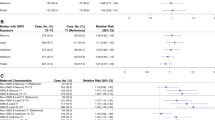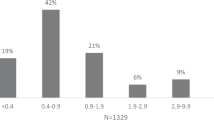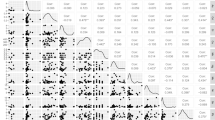Abstract
Arsenic is a carcinogen that can also affect the cardiac, respiratory, neurological and immune systems. Children have higher dietary arsenic exposure than adults owing to their more restricted diets and greater intake per unit body mass. We evaluated the potential contributions of breast milk and formula to arsenic exposure throughout the first year of life for 356 infants in the prospective New Hampshire Birth Cohort Study (NHBCS) using infant diets reported by telephone at 4, 8 and 12 months of age; measured household water arsenic concentrations; and literature data. Based on our central-tendency models, population-wide geometric mean (GM) estimated arsenic exposures in the NHBCS were relatively low, decreasing from 0.1 μg/kg/day at 4 months of age to 0.07 μg/kg/day at 12 months of age. At all three time points, exclusively formula-fed infants had GM arsenic exposures ~8 times higher than exclusively breastfed infants owing to arsenic in both tap water and formula powder. Estimated maximum exposures reached 9 μg/kg/day among exclusively formula-fed infants in households with high tap water arsenic (80 μg/l). Overall, modeled arsenic exposures via breast milk and formula were low throughout the first year of life, unless formula was prepared with arsenic-contaminated tap water.
This is a preview of subscription content, access via your institution
Access options
Subscribe to this journal
Receive 6 print issues and online access
$259.00 per year
only $43.17 per issue
Buy this article
- Purchase on Springer Link
- Instant access to full article PDF
Prices may be subject to local taxes which are calculated during checkout


Similar content being viewed by others
References
Farzan SF, Karagas MR, Chen Y . In utero and early life arsenic exposure in relation to long-term health and disease. Toxicol Appl Pharmacol 2013; 272: 384–390.
Naujokas MF, Anderson B, Ahsan H, Vasken Aposhian H, Graziano JH, Thompson C et al. The broad scope of health effects from chronic arsenic exposure: update on a worldwide public health problem. Environ Health Perspect 2013; 121: 8.
Rahman A, Persson LA, Nermell B, El Arifeen S, Ekstrom EC, Smith AH et al. Arsenic exposure and risk of spontaneous abortion, stillbirth, and infant mortality. Epidemiology 2010; 21: 797–804.
Vahter M . Health effects of early life exposure to arsenic. Basic Clin Pharmacol Toxicol 2008; 102: 204–211.
Roy A, Kordas K, Lopez P, Rosado JL, Cebrian ME, Vargas GG et al. Association between arsenic exposure and behavior among first-graders from Torreon, Mexico. Environ Res 2011; 111: 670–676.
Hamadani JD, Tofail F, Nermell B, Gardner R, Shiraji S, Bottai M et al. Critical windows of exposure for arsenic-associated impairment of cognitive function in pre-school girls and boys: a population-based cohort study. Int J Epidemiol 2011; 40: 1593–1604.
Kwok RK, Kaufmann RB, Jakariya M . Arsenic in drinking-water and reproductive health outcomes: a study of participants in the Bangladesh integrated nutrition programme. J Health Popul Nutr 2006; 24: 190–205.
Steinmaus C, Ferreccio C, Acevedo J, Yuan Y, Liaw J, Duran V et al. Increased lung and bladder cancer incidence in adults after in utero and early-life arsenic exposure. Cancer Epidemiol Biomarkers Prev 2014; 23: 1529–1538.
Bodwell JE, Kingsley LA, Hamilton JW . Arsenic at very low concentrations alters glucocorticoid receptor (GR)-mediated gene activation but not GR mediated gene repression; complex dose response effects are closely correlated with levels of activated GR and require a functional GR DNA binding domain. Chem Res Toxicol 2004; 17: 1064–1076.
Farzan SF, Korrick S, Li Z, Enelow R, Gandolfi AJ, Madan J et al. In utero arsenic exposure and infant infection in a United States cohort: a prospective study. Environ Res 2013; 126: 24–30.
Argos M, Kalra T, Rathouz PJ, Chen Y, Pierce B, Parvez F et al. Arsenic exposure from drinking water, and all-cause and chronic-disease mortalities in Bangladesh (HEALS): a prospective cohort study. Lancet 2010; 376: 252–258.
Chen CJ, Wang CJ . Ecological correlation between arsenic level in well water and age-adjusted mortality from malignant neoplasms. Cancer Res 1990; 50: 5470–5474.
Samanta G, Sharma R, Roychowdhury T, Chakraborti D . Arsenic and other elements in hair, nails, and skin-scales of arsenic victims in West Bengal, India. Sci Total Environ 2004; 326: 33–47.
Cubadda F, Aureli F, D'Amato M, Raggi A, Turco AC, Mantovani A . Speciated urinary arsenic as a biomarker of dietary exposure to inorganic arsenic in residents living in high-arsenic areas in Latium, Italy. Pure Appl Chem 2012; 84: 203–214.
Karagas MR, Stukel TA, Tosteson TD . Assessment of cancer risk and environmental levels of arsenic in New Hampshire. Int J Hyg Environ Health 2002; 205: 85–94.
International Agency for Research on Cancer (IARC) Some Drinking-Water Disinfectants and Contaminants, Including Arsenic. World Health Organization: Lyon, France. 2004.
Edmonds JS, Francesconi KA . Arsenic in seafoods - human health-aspects and regulations. Mar Pollut Bull 1993; 26: 665–674.
Meharg A, Sun G, Williams PN, Adomako EE, Deacon C, Zhu Y-G et al. Inorganic arsenic levels in baby rice are of concern. Environ Pollut 2008; 152: 746–749.
Tseng CH . A review on environmental factors regulating arsenic methylation in humans. Toxicol Appl Pharmacol 2009; 235: 338–350.
Gosse JA, Taylor VF, Jackson BP, Hamilton JW, Bodwell JE . Monomethylated trivalent arsenic species disrupt steroid receptor interactions with their DNA response elements at non-cytotoxic cellular concentrations. J Applied Toxicol 2014; 34: 498–505.
Medeiros M, Zheng X, Novak P, Wnek SM, Chyan V, Escudero-Lourdes C et al. Global gene expression changes in human urothelial cells exposed to low-level monomethylarsonous acid. Toxicology 2012; 291: 102–112.
Styblo M, Del Razo LM, Vega L, Germolec DR, LeCluyse EL, Hamilton GA et al. Comparative toxicity of trivalent and pentavalent inorganic and methylated arsenicals in rat and human cells. Arch Toxicol 2000; 74: 289–299.
Petrick JS, Ayala-Fierro F, Cullen WR, Carter DE, Vasken Aposhian H . Monomethylarsonous acid (MMA(III)) is more toxic than arsenite in Chang human hepatocytes. Toxicol Appl Pharmacol 2000; 163: 203–207.
Cohen SM, Arnold LL, Eldan M, Lewis AS, Beck BD . Methylated arsenicals: the implications of metabolism and carcinogenicity studies in rodents to human risk assessment. Crit Rev Toxicol 2006; 36: 99–133.
Cohen SM, Arnold LL, Beck BD, Lewis AS, Eldan M . Evaluation of the carcinogenicity of inorganic arsenic. Crit Rev Toxicol 2013; 43: 711–752.
European Food Safety Authority (EFSA). EFSA Panel on Contaminants in the Food Chain (CONTAM): Scientific Opinion on Arsenic in Food. EFSA J 2009; 7: 1351.
Tsuji JS, Yost LJ, Barraj LM, Scrafford CG, Mink PJ . Use of background inorganic arsenic exposures to provide perspective on risk assessment results. Regul Toxicol Pharmacol 2007; 48: 59–68.
Hernandez-Martinez R, Navarro-Blasco I . Survey of total mercury and arsenic content in infant cereals marketed in Spain and estimated dietary intake. Food Control 2013; 30: 423–432.
Ljung K, Palm B, Grander M, Vahter M . High concentrations of essential and toxic elements in infant formula and infant foods - a matter of concern. Food Chem 2011; 127: 943–951.
Sorbo A, Turco AC, Di Gregorio M, Ciaralli L . Development and validation of an analytical method for the determination of arsenic, cadmium and lead content in powdered infant formula by means of quadrupole inductively coupled plasma mass spectrometry. Food Control 2014; 44: 159–165.
Jackson BP, Taylor VF, Punshon T, Cottingham KL . Arsenic concentration and speciation in infant formulas and first foods. Pure Appl Chem 2012; 84: 215–223.
U.S. Food and Drug Administration. Analytical Results from Inorganic Arsenic in Rice and Rice Products Sampling. Arsenic in Rice and Rice Products. 2013; http://www.fda.gov/downloads/Food/FoodborneIllnessContaminants/Metals/UCM352467.pdf. (accessed 4 September 2015).
Carignan CC, Cottingham KL, Jackson BP, Farzan SF, Gandolfi AJ, Punshon T et al. Estimated exposure to arsenic in breastfed and formula-fed infants in a United States Cohort. Environ Health Perspect 2015; 123: 500–506.
Björklund KL, Vahter M, Palm B, Grandér M, Lignell S, Berglund M . Metals and trace element concentrations in breast milk of first time healthy mothers: a biological monitoring study. Environ Health 2012; 11: 92.
Samanta G, Das D, Mandal BK, Chowdhury TR, Chakraborti D, Pal A et al. Arsenic in the breast milk of lactating women in arsenic-affected areas of West Bengal, India and its effect on infants. J Environ Sci Health A Tox Hazard Subst Environ Eng 2007; 42: 1815–1825.
Concha G, Vogler G, Nermell B, Vahter M . Low-level arsenic excretion in breast milk of native Andean women exposed to high levels of arsenic in the drinking water. Int Archiv Occup Environ Health 1998; 71: 42–46.
Fängström B, Moore S, Nermell B, Kuenstl L, Goessler W, Grandér M et al. Breast-feeding protects against arsenic exposure in Bangladeshi infants. Environ Health Perspect 2008; 116: 963–969.
Sternowsky HJ, Moser B, Szadkowsky D . Arsenic in breast milk during the first 3 months of lactation. Int J Hyg Environ Health 2002; 205: 405–409.
Islam MR, Attia J, Alauddin M, McEvoy M, McElduff P, Slater C et al. Availability of arsenic in human milk in women and its correlation with arsenic in urine of breastfed children living in arsenic contaminated areas in Bangladesh. Environ Health 2014; 13: 101.
Vahter ME, Li L, Nermell B, Rahman A, El Arifeen S, Rahman M et al. Arsenic exposure in pregnancy: a population-based study in Matlab, Bangladesh. J Health Popul Nutr 2006; 24: 236–245.
Centers for Disease Control and Prevention (CDC). Breastfeeding Report Card, United States, 2013. Centers for Disease Control and Prevention, National Center for Chronic Disease Prevention and Health Promotion, Division of Nutrition, Physical Activity and Obesity. http://www.cdc.gov/breastfeeding/pdf/2013breastfeedingreportcard.pdf.
Gilbert-Diamond D, Cottingham KL, Gruber JF, Punshon T, Sayarath V, Gandolfi AJ et al. Rice consumption contributes to arsenic exposure in US women. Proc Natl Acad Sci USA 2011; 108: 20656–20660.
U.S. Environmental Protection Agency (US EPA) Child-Specific Exposure Factors Handbook (Final Report). U.S. Environmental Protection Agency: Washington, DC, USA. 2008. http://cfpub.epa.gov/ncea/cfm/recordisplay.cfm?deid=1992432008.
U.S. Environmental Protection Agency. Chronic Health Hazard Assessments for Noncarcinogenic Effects, Reference Dose for Chronic Oral Exposure (RfD). Integrated Risk Information System (IRIS) on inorganic arsenic. Verification date February 3, 1994. http://www.epa.gov/iris/subst/0278.htm.
National Research Council Critical Aspects of EPA's IRIS Assessment of Inorganic Arsenic: Interim Report. National Academies Press: Washington, DC, USA. 2013. http://www.nap.edu/catalog.php?record_id=18594.
Josyula AB, McClellen H, Hysong TA, Kurzius-Spencer M, Poplin GS, Sturup S et al. Reduction in urinary arsenic with bottled-water intervention. J Health Popul Nutr 2006; 24: 298–304.
Meharg AA, Sun GX, Williams PN, Adomako E, Deacon C, Zhu YG et al. Inorganic arsenic levels in baby rice are of concern. Environ Pollut 2008; 152: 746–749.
Lai PY, Cottingham KL, Steinmaus C, Karagas MR, Miller MD . Arsenic and rice: translating research to address health care providers' needs. J Ped 2015; 167: 797–803.
Acknowledgements
We thank the participants and staff members of the New Hampshire Birth Cohort Study and members of the Cottingham Laboratory for their assistance. Archana Ramanujan and David Fried conducted the medical record reviews for infant body weights. Patricia Fabian and three anonymous reviewers provided helpful comments on a draft manuscript. This publication was supported in part by grants P01 ES022832 and P20 ES018175 from the National Institute of Environmental Health Sciences (NIEHS) and RD83459901 and RD83544201 from the Environmental Protection Agency (EPA). Contents are solely the responsibility of the grantee and do not necessarily represent the official views of the US EPA. Further, the US EPA does not endorse the purchase of any commercial products or services mentioned in the publication.
Author information
Authors and Affiliations
Corresponding author
Ethics declarations
Competing interests
The authors declare no conflict of interest.
Additional information
Supplementary Information accompanies the paper on the Journal of Exposure Science and Environmental Epidemiology website
Supplementary information
Rights and permissions
About this article
Cite this article
Carignan, C., Karagas, M., Punshon, T. et al. Contribution of breast milk and formula to arsenic exposure during the first year of life in a US prospective cohort. J Expo Sci Environ Epidemiol 26, 452–457 (2016). https://doi.org/10.1038/jes.2015.69
Received:
Revised:
Accepted:
Published:
Issue Date:
DOI: https://doi.org/10.1038/jes.2015.69
Keywords
This article is cited by
-
Health risk assessments of heavy metals and trace elements exposure in the breast milk of lactating mothers in the Northeastern Iran
Environmental Science and Pollution Research (2024)
-
Dietary Exposure to Essential and Non-essential Elements During Infants’ First Year of Life in the New Hampshire Birth Cohort Study
Exposure and Health (2023)
-
Contamination of breast milk with lead, mercury, arsenic, and cadmium in Iran: a systematic review and meta-analysis
BioMetals (2022)
-
Associations of Metals and Neurodevelopment: a Review of Recent Evidence on Susceptibility Factors
Current Epidemiology Reports (2020)
-
Infants’ dietary arsenic exposure during transition to solid food
Scientific Reports (2018)



